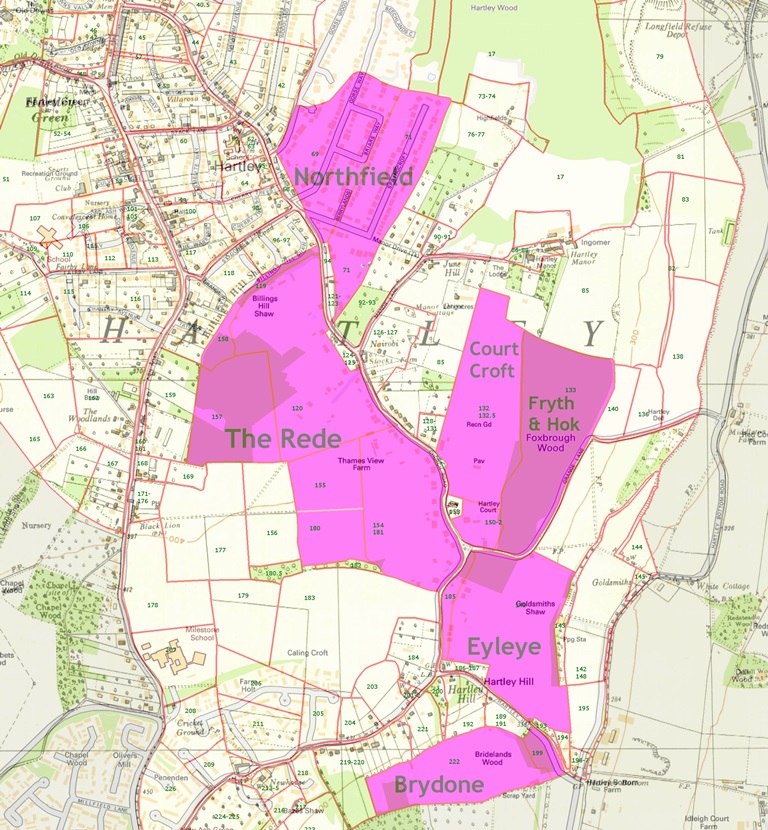Hartley Court 1392
This is a survey held in the National Archives, listing the monetary value of the manor of Hartley in 1392. It was made by a local jury of the more prominent tenants. See plan below for an approximate indication of where the fields mentioned were. The manor house was where Hartley Court, Church Road is today.
It is possible that this survey is referring to open fields at Hartley, which is suggested by the language used. Also Middle Farm had a field called The Reede in 1624 (roughly where Stack Lane is today). This is some debate as to what open fields mean in Kent, as the county is not thought to have the classic midland style open fields farmed in common.
Hertley in the county of Kent
Extent of the manor made there on 14 February in the said year (1392) by the oaths of John Faver, William Dalton [1], John Smyth, Laurence Smyth, Robert Crabbe, Walter Dalton and Geoffrey of ye Stable.
Demesne
Who say on their oath that there is a small hall there with one solar [2] at each end for the bailiff; one ruinous thatched granary; one thatched cattle shed for horses and cattle; two thatched granges.
Rights
And that the lord of this manor shall have the fines for bread and ale, infangentheof [3] and outfangtheof [4] and all others pertaining to a view of frankpledge [5].
Arable Land
And there are 100 acres of arable land in a field there [6] called "Le Rede", worth 4d per acre. Value therefor - 33s 4d.
And there are 50 acres of arable land in "Le Northfeld", worth 4d per acre. Value therefor - 16s 8d.
And there are 16 acres of arable land in "Cutcroft", worth 6d per acre. Value therefor - 8s.
And there are 30 acres of arable land in a field called "Eyleye", worth 4d per acre. Value therefor - 10s.
And there are 10 acres of arable land in a croft called "Brydone", worth 4d per acre. Value therefor - 3s 4d.
Meadow for Mowing
And there are 5 acres of meadow in the demesne, worth 2s 6d per acre. Value therefor - 12s 6d.
Pasture
And there is a certain pasture within the garden and woods next to the manor which is worth per annum - 20s.
Rents of Assise with rents for works and services [7]
And there is there for rents of assise [8] and the four usual terms - £8
And there is there for rents of chickens and eggs per annum - 2s ii[.....d]
And there is there for the rent of 18 acres of ploughing, per annum at 12d per [.....]
And there Is there for the rent of 16 acres of mowing at [....] per acre [......]
And there is there for 12 (Latin - vom' ?) of rent per annum for a piece [......]
Profits of the (Manor) Court
The profits of the court there are worth, after expenses - 18s
Advowson of the Church
The advowson [9] of the church there does not pertain to the lord of this manor
Big Timber
And there is there a wood called "Le Fryth" of old and big timber, containing 5 acres and is worth 53s 4d per acre. Value therefor - £13 6s 8d.
And there is there another wood called "Le Hok", containing 10 acres of young wood, worth 13s 4d per acre. Value therefor - £6 13s 4d.
Memorandum
And memorandum that all tenants there ought to common will all their animals except pigs, on all the lands of the demesne there, except the garden and woods, between the feast of St Martin and the feast of the Purification of the Blessed Virgin Mary [10].
Map showing 1392 estate superimposed on modern map.

Notes
[4] The right of the lord of the manor to arrest thieves outside the manor and try them in the manor.
[6] The Latin terminology used here would suggest that The Rede and Northfield may still have been open fields at this time.
